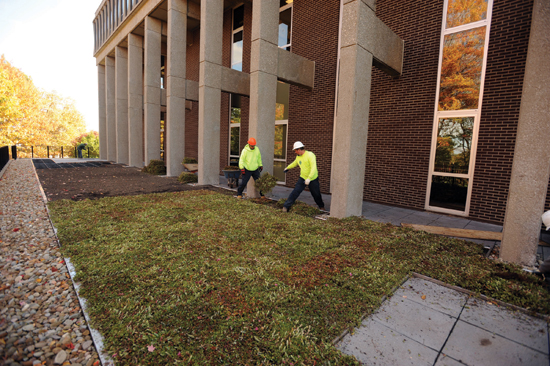Building Green
The tray-based green roof assemblies have a more restricted range of planting depths but they are the easiest to install and provide easy access to maintain the roof membrane underneath. The trays are, however, interlocking and once all of the trays are locked together, the medium can be surcharged and the depth can be increased by adding 3 to 4 inches of soil on top of the trays. The most common plants used in extensive green roofs are sedums, which are extremely hardy and come in a wide variety of different mixtures for specific regions and aesthetic goals. The tray systems are designed for the best stormwater management properties. They meet multiple LEED MR criteria as they have components that are manufactured from 88 percent recycled content. The tray assemblies also have internal drip irrigation built into the trays.
The structural requirement for green roofs is dependent on the size of the roof, the size and depth of the soil, and the growing medium. The design of larger roof gardens for the assembly can be very involved, especially when stormwater management calculations are required, but the green roof technology team will provide an accurate weight calculation based on the green roof's required size, depth, and water retention.
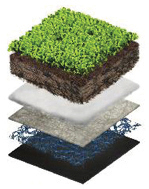 |
Detail showing a green roof multi-layer assembly Image courtesy of Columbia Green Technologies |
Green roof technologies must meet FLL guidelines, which are standards that were developed in Germany for growing media and which have been accepted in the U.S. These standards govern the growing medium and evaluate its air porosity and maximum saturated weight. Other standards which must be met are Factory Mutual Assurance (FM) certifications.3 In addition, green roof technologies for stormwater management must meet the latest LEED v4 Materials and Resources criteria for Environmental Product Declarations by providing a listing of all ingredients used in the assemblies and membrane for the system. The Declare label ensures that all components are “red list free” meaning that it is free of toxins and it meets the standards for certification through the Living Building Challenge.4
With respect to specifying this product for a project, it is recommended that Master Format Section 07 55 63 Vegetated Protected Membrane Roofing of the Construction Specifications Institute (CSI) be used to provide better coordination between the architect and the landscape architect on the project.
Green roof technologies for stormwater management have been implemented at a number of locations throughout the U.S. and Canada including Kent State University's Taylor Hall in Kent State, Ohio, and Horizon House Retirement Community in Seattle, Washington.
Beth Ruffing, assistant director in the Office of the University Architect and project manager for the roof garden on Kent State University's Taylor Hall, says, “green roofs can have many environmental benefits; they reduce cooling costs for buildings and they slow the speed of stormwater to release stress on drainage systems. In addition, they're visually appealing and provide an opportunity for our students to learn about sustainability.” She continues, “this green roof will require very little maintenance. The sedum plants are watered by an integrated irrigation system and do not require mowing or chemical weed control.”
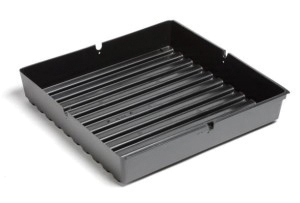 |
Detail showing an empty tray for the green roof tray assembly Photo courtesy of Columbia Green Technologies |
Meanwhile, at the Horizon House, “a dynamic retirement community dedicated to dignified aging,” the green roof is “an integral part of providing a healthy, green, and sustainable residential environment,” says Brad D'Emidio, director of Building Services and the Horizon House Retirement Community.
Green roof technologies for stormwater management reflect an upward trend in green roof technology that meets all of the private, public, and design-based benefits and also addresses tax-credit incentives that are now being introduced in various communities such as in Washington, D.C., where planning policy provides credits for plans that utilize green roofs to help to manage stormwater.
The city of Seattle, Washington has an innovative development standard called the Seattle Green Factor (SGF), which is a scoring system designed to promote ecologically functional as well as attractive urban landscaping and which provides incentives for the use of green roofs as well as other green building technologies.5
The benefits of green roof technology are wide ranging. They include management of stormwater, reduction of heat island effects, restoration of habitat, biodiversity of plant and wildlife, water efficiency, energy optimization through both cooling and heating, reuse of building materials, recycled-content materials, increased roof durability and longevity, and creation of rooftop amenity spaces. |
Notice
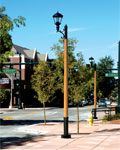
www.cavawood.com
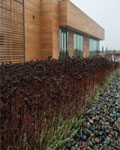
www.columbia-green.com
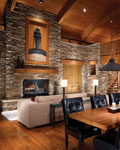
www.eldoradostone.com
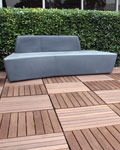
www.tournesolsiteworks.com/boulevard.html





